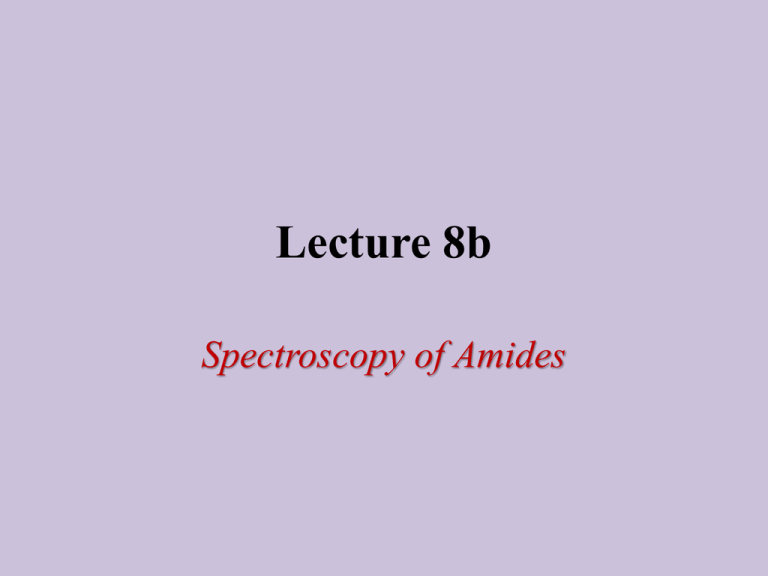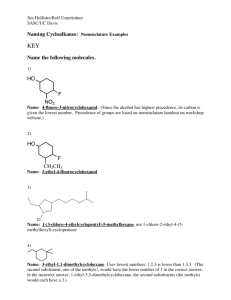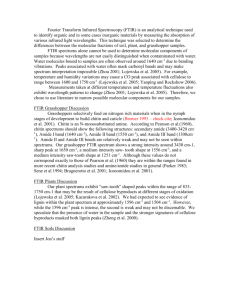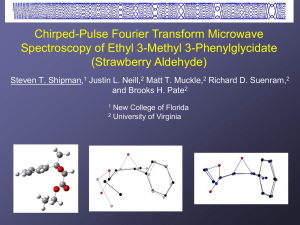Chem 30CL_Lecture 8b..
advertisement

Lecture 8b Spectroscopy of Amides Infrared Spectroscopy • The location of the carbonyl stretching frequency varies significantly between the different carbonyl functionalities (CH3COX, HF/6-31**): Carbonyl compound CH3COBr CH3COCl (CH3CO)2O CH3COOCH3 CH3COOH CH3CON(CH3)2 Reactivity extremely high extremely high very high medium low extremely low ν(C=O) 1817 cm-1 1806 cm-1 1761 cm-1 1748 cm-1 1715 cm-1 1662 cm-1 d(C=O)X 116.3 pm 116.7 pm 117.8 pm 118.8 pm 118.7 pm 120.2 pm Bond order 1.939 1.937 1.848 1.835 1.870 1.718 pKa of acid (-9) (HBr) (-7) (HCl) ~3-5 (RCOOH) 16-19 (ROH) 16 (H2O) 38 (NH3) • The table shows that a shorter the C=O bond is associated with a higher carbonyl stretching frequency: • Acyl chlorides are on the high end of this range because of the inductive effect of the chlorine atom (B.O. for (C=O)=1.937 (CH3COCl)). • Amides are found on the low end of the range because of the strong resonance effect (B.O. for (C=O)=1.718 (CH3CON(CH3)2)). The C-N bond is usually significantly shorter in amide compared to amines due to the partial double bond ((B.O. for (C-N)=1.14). O R O N R N NMR Spectroscopy I • 1H and 13C-NMR Spectra • How many signals would we expect to see on the 1H-NMR and the 13C-NMR spectrum? • The additional signals are observed due to the lower apparent symmetry i.e., two signals for the methyl groups in the 1H-NMR and the 13C-NMR spectrum. The spectra are temperature and solvent dependent. • Compound Rotational Barrier N,N-Dimethylformamide 86 kJ/mol (D2O) N,N-Dimethylacetamide 69 kJ/mol (D2O) N,N-Dimethylpropionamide 69 kJ/mol (D2O) N,N-Dimethylbenzamide 66 kJ/mol (CDCl3) NMR Spectroscopy II • DEET T=370 K O H3C N • If a free rotation about the O=C-N bond was observed, there should be three signals in the range below 4.0 ppm. • Three signals are observed at high temperatures, but five signals at room temperature and below because of the slow rotation which makes the two ethyl groups non-equivalent. T=320 K T=300 K T=280 K Example • N,N-Diethylformamide • What would be expect to observe in the 1H-NMR spectrum? • How can one rationalize the quintet at d=3.3 ppm and the quartet at d=1.1 ppm? • Two overlapping quartets or triplets, respectively Amide Conformers I • Secondary amides are found as trans- or/and cis-conformers (rotamers) • For bulky R’-groups (i.e., tert.-Bu, Ph, o-Tol, etc.), the cis rotamer is dominant in solution (CDCl3) • For R’-groups that contain atoms like nitrogen (i.e., lidocaine) or oxygen in a reasonable distance, the trans rotamer is favored due to the possibility of intramolecular hydrogen bonding • A lower n(NH) stretching mode (n<3300 cm-1) and increase in the d(NH) mode (d>1500 cm-1) • An increased chemical shift of the amide proton (d=9.5-11 ppm) • At higher concentrations, aggregates of the trans rotamer are found in solution. Amide Conformers II • Example 1: N-Ethylformamide (0.5 mL : 1.5 mL CDCl3) trans trans trans cis cis cis • Two sets of signals due to the cis rotamer (small signals) and trans rotamer (large signals) conformers in the solution • The trans conformer clearly being favored here (88:12) Amide Conformers III • Example 1: N-Ethylacetamide (0.5 mL : 1.5 mL CDCl3) • For R-groups that are larger than H, the trans rotamer is usually highly favored



